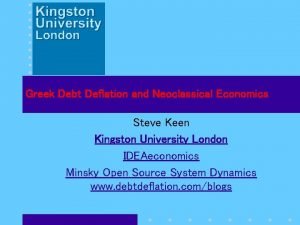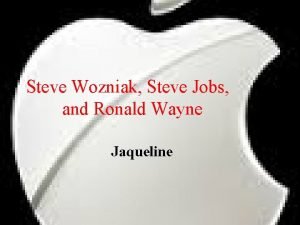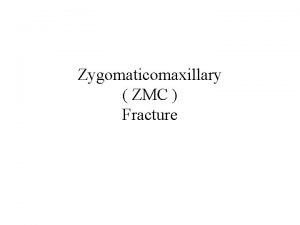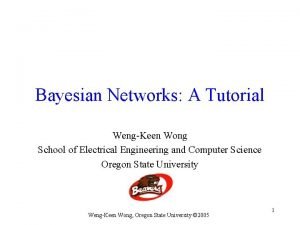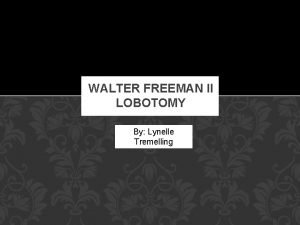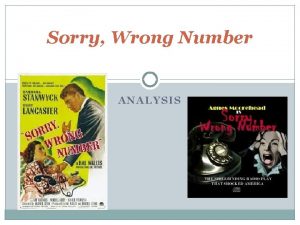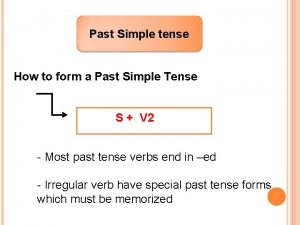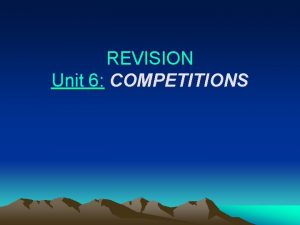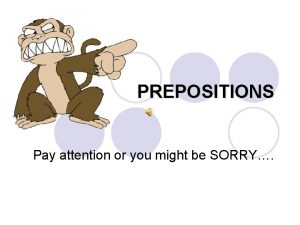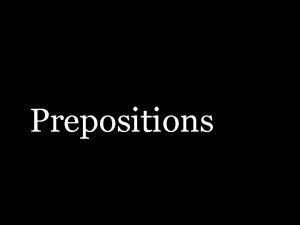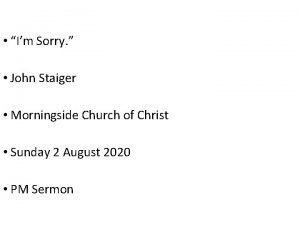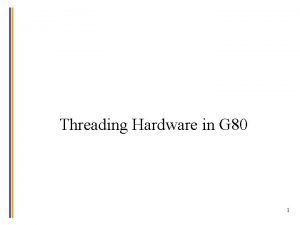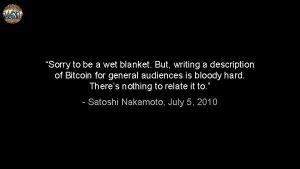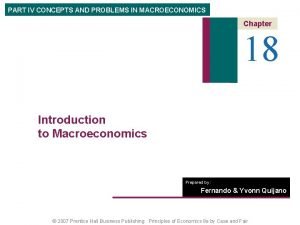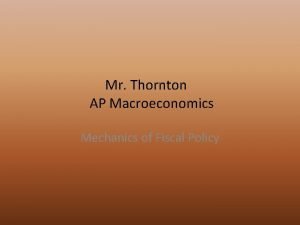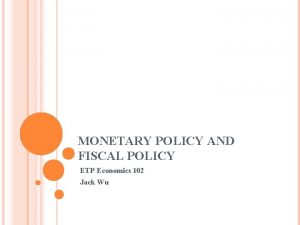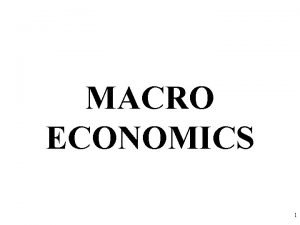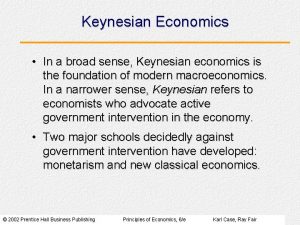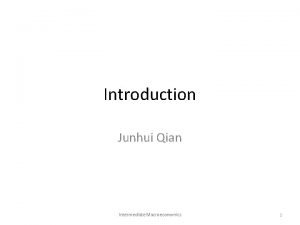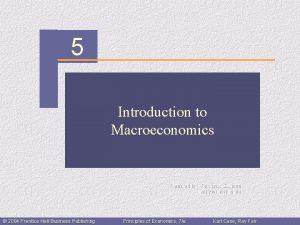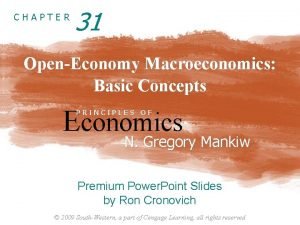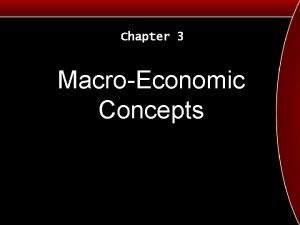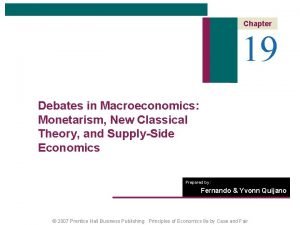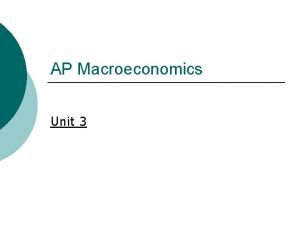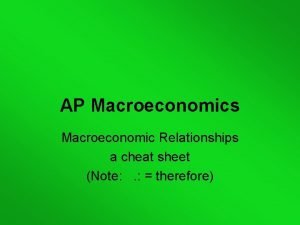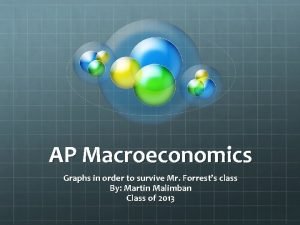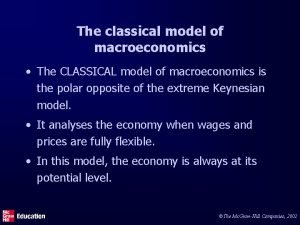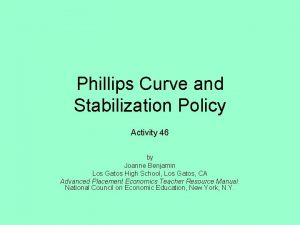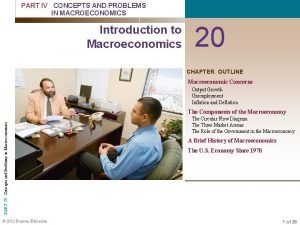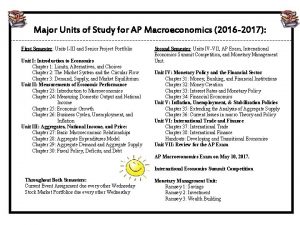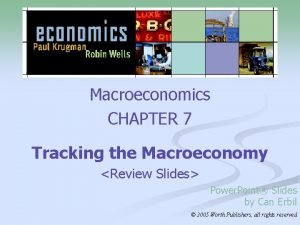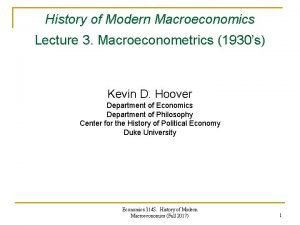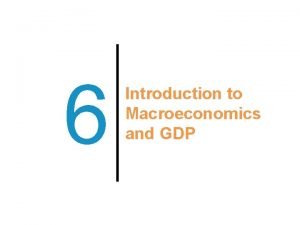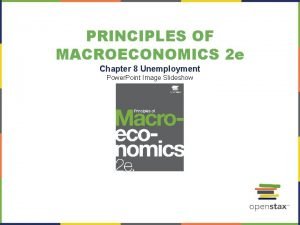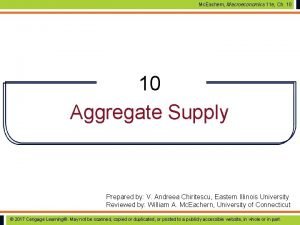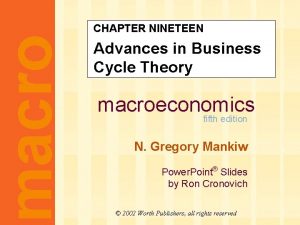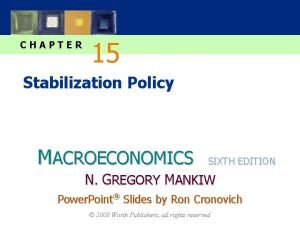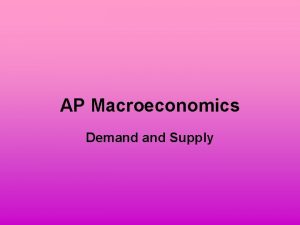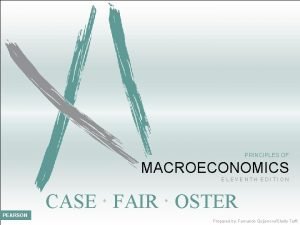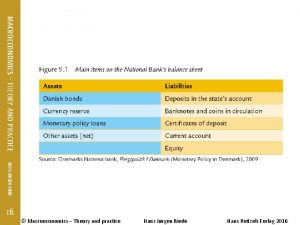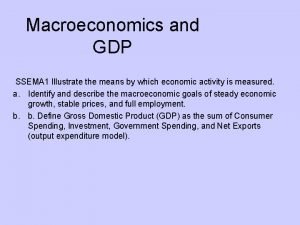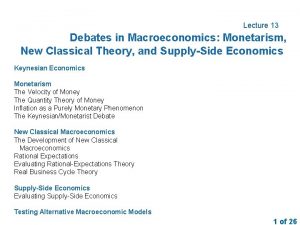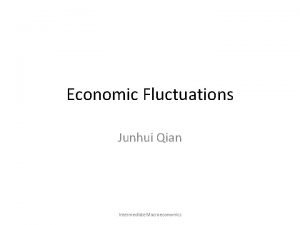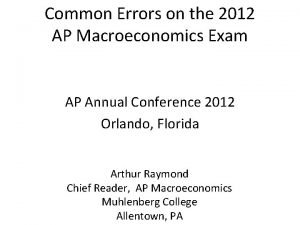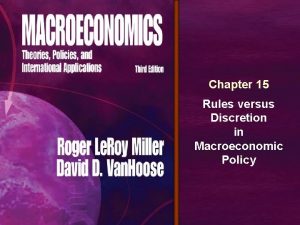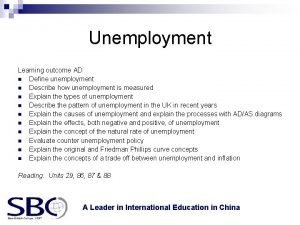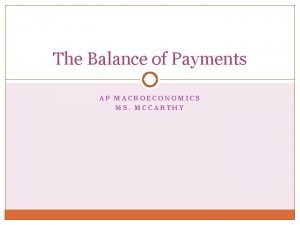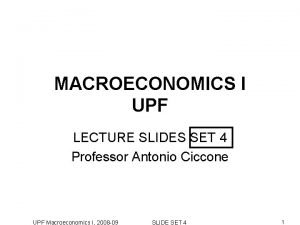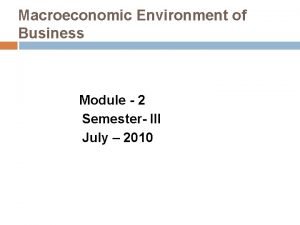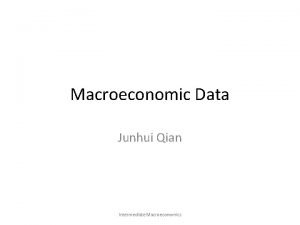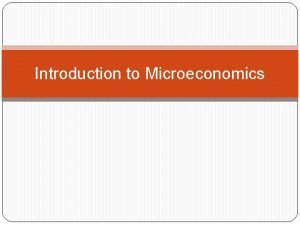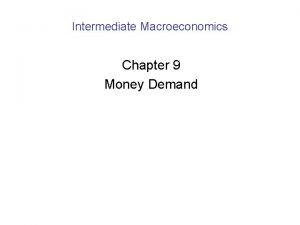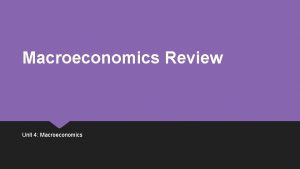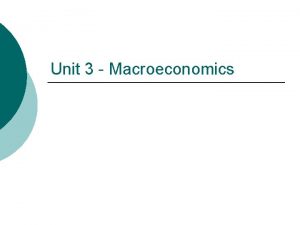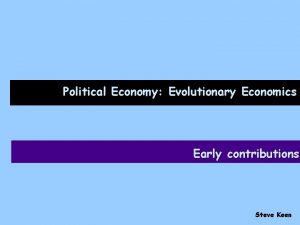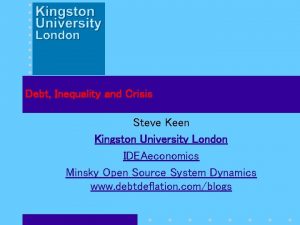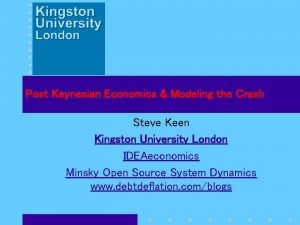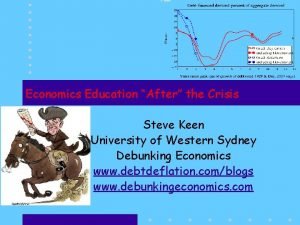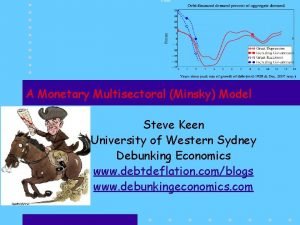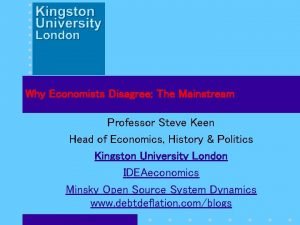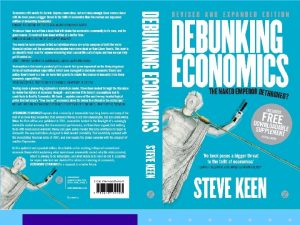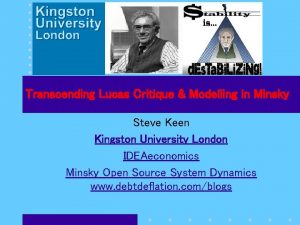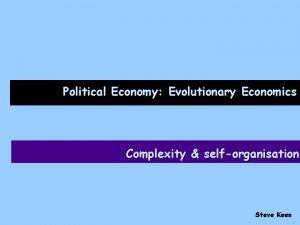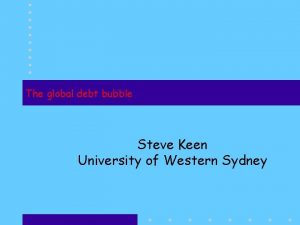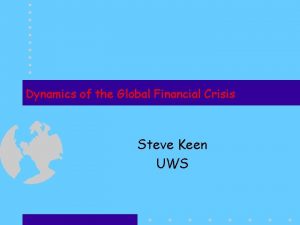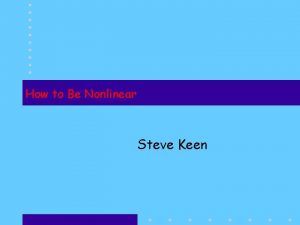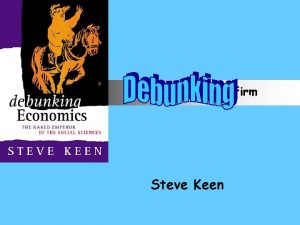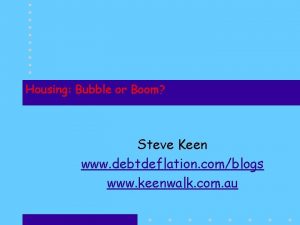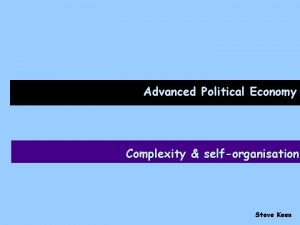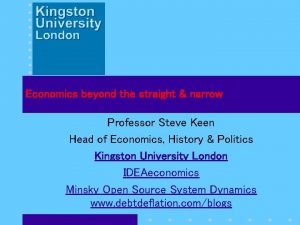The Sorry History of Macroeconomics Steve Keen In






































































































- Slides: 102

The Sorry History of Macroeconomics Steve Keen

In the beginning… • Were the Physiocrats! – First school of thought with clear macro-economic concepts • Circular flow of income • Production & distribution of surplus • “Multiplier” effects from change in investment… • With Smith, a “great leap backward” – Macro issues almost completely disappeared • Belief market system would not suffer from “permanent glut” – “Invisible hand” comment misinterpreted, but gist correct as statement of belief • Ricardo’s framework admitted macro issues, but bizarrely…

Was Jean Baptiste Say… • Accepted Say’s macro vision (“no general glut”) even though value systems fundamentally different – Ricardo heir to Smith in classical scheme • Value reflects effort, not utility: – “everything rises or falls in value, in proportion to the facility or difficulty of producing it, or, in other words, in proportion to the quantity of labour employed on its production. ” (Ricardo, Principles) • Utility a pre-requisite for exchange, but plays no role in setting value:

Was Say… • “Utility then is not the measure of exchangeable value, although it is absolutely essential to it. ” Ricardo, Principles. – Caveat that “If a commodity were in no way useful … it would be destitute of exchangeable value, however scarce it might be, or whatever quantity of labour might be necessary to procure it. ” • Changes in perceived utility/demand may change temporary market price, but ultimately when equilibrium restored, value determines price • Despite this very non-neoclassical microfoundation, Ricardo accepted Say’s microeconomic argument that there could not be macroeconomic problems:

Was Say… • “M. Say has, however, most satisfactorily shewn, that there is no amount of capital which may not be employed in a country, because demand is only limited by production. No man produces, but with a view to consume or sell, and he never sells, but with an intention to purchase some other commodity, which may be immediately useful to him, or which may contribute to future production. By producing, then, he necessarily becomes either the consumer of his own goods, or the purchaser and consumer of the goods of some other person…” (Ricardo Principles; emphasis added)

Was Say… • “Productions are always bought by productions, or by services; money is only the medium by which the exchange is effected. Too much of a particular commodity may be produced, of which there may be such a glut in the market, as not to repay the capital expended on it; but this cannot be the case with respect to all commodities; the demand for corn is limited by the mouths which are to eat it, for shoes and coats by the persons who are to wear them; but though a community, or a part of a community, may have as much corn, and as many hats and shoes, as it is able or may wish to consume, the same cannot be said of every commodity produced by nature or by art. ” • So according to Ricardo, following Say, there cannot be insufficient aggregate demand…

“Say’s Law” • Say (writing 1821 -34) – “Utility” theory of value (contra. Smith & Ricardo): • “Give to a thing, to a material which has no value, utility, and you give it a value; that is, … you create wealth. ” (Catechism of Political Economy) – Utility subjective: • “you call only useful that which is so to the eye of reason, but you ought to understand by that word whatever is capable of satisfying the wants and desires of man such as he is. . . He is the sole judge of the importance that things are of to him, . . . We cannot judge of it but by the price he puts on them. ”

“Say’s Law” • Crises caused by “disproportionality” only – Excess supply in one market, excess demand in others • “General gluts” or “general slumps” impossible • Argument – Money only an intermediary in barter – People sell only to buy again (increase in utility the object) • Each person’s supply is matched to his/her demand – Sum of all supply thus cannot exceed sum of all demand (no “general gluts”); but

“Say’s Law” • Slumps in one market can occur if supply of X exceeds demand for X at price producers of X want; however – Unless government regulations, monopolies intervene – Price of X falls, demand for X rises: equilibrium… • Basic logic “micro” in nature – Hypothesis about behaviour of each individual in market system (micro) – Aggregate hypothesis to overall economy (macro) – Argument also essential “real” rather than monetary:

“Say’s Law” • “Every producer asks for money in exchange for his products, only for the purpose of employing that money again immediately in the purchase of another product; for we do not consume money, and it is not sought after in ordinary cases to conceal it: …. It is thus that the producers, though they have all of them the air of demanding money for their goods, do in reality demand merchandise for their merchandise. ” – So micro balance of each consumer/producer ensures overall macro balance • Some markets may have over-supply; others will be under-supplied; changes in prices will equilibrate. • All markets in aggregate balanced

Marx and the “Circuits of Capitalism” • Marx provides best rejection of Say: – Not true that “Every producer asks for money in exchange for his products, only for the purpose of employing that money again immediately in the purchase of another product” – Some “producers” motivated not by consumption but by accumulation: capitalists • Capitalist objective not commodities but money/wealth • Will withdraw from market if fear can’t turn produced commodities into money profits – They do seek “in ordinary cases to conceal [money]” – Demand not “merchandise for their merchandise” but “more money for their money” • “Say’s Law” fits economy of simple commodity producers— but not capitalism

Marx and the “Circuits of Capitalism” • Marx worked out flaw while writing “Rough Draft” of Capital in 1857: – The commodity is exchanged for money; money is exchanged for the commodity. In this way, commodity is exchanged for commodity, except that this exchange is a mediated one. The purchaser becomes a seller again and the seller becomes purchaser again. In this way, each is posited in the double and the antithetical aspect, and hence in the living unity of both aspects. (Marx 1857: 197) • Circulation of commodity A to money to commodity B – “One moment of circulation is that the commodity exchanges itself through money for another commodity. ” (204) • But there is a second, vital, unbalanced capitalist circuit:

Marx and the “Circuits of Capitalism” • “But there is, equally, the other moment, not only that commodity exchanges for money and money for commodity, but equally that money exchanges for commodity and commodity for money; hence that money is mediated with itself by the commodity, and appears as the unity which joins itself with itself in its circular course. • Then it appears no longer as the medium, but as the aim of circulation (as e. g. with the merchant estate) (in commerce generally). If circulation is looked at not as a constant alternation, but as a series of circular motions which it describes within itself, then this circular path appears as a double one: Commodity-Money-Commodity and in the other direction Money-Commodity-Money; i. e. if I sell in order to buy, then I can also buy in order to sell. • In the former case money only as a means to obtain the commodity, and the commodity the aim; in the second case the commodity only a means to obtain money, and money the aim. ” (Marx 1857: 201; emphases added).

Marx and the “Circuits of Capitalism” • Balance of value makes sense in 1 st circuit – Exchange one commodity for another – Equivalents exchanged: $ value of commodity A equals $ value of commodity B – Differences in qualitative utility the result • Seller of A/Buyer of B prefers B to A • Ditto in reverse • But balance doesn’t make sense in 2 nd circuit – Exchange of money for money only sensible if second quantity exceeds the first:

Marx and the “Circuits of Capitalism” • “Now one can say: to exchange commodity for commodity makes sense, since commodities, although they are equivalent as prices, are qualitatively different, and their exchange ultimately satisfies qualitatively different needs. • By contrast, exchanging money for money makes no sense, unless, that is, a quantitative difference arises, less money is exchanged for more, sold at a higher price than purchased… • In the real process of buying in order to sell, admittedly, the motive is the profit made thereby, and the ultimate aim is to exchange less money, by way of the commodity, for more money, since there is no qualitative difference between money and money. • All that given, it cannot be denied that the operation may come to grief and that hence the exchange of money for money without quantitative difference frequently takes place in reality. ” (Marx 1857: 201– 02; emphases added)

Marx and the “Circuits of Capitalism” • Money incidental to barter; merely makes it easier • But money essential to understanding capitalism: – “money functions neither only as measure, nor only as medium of exchange, nor only as both; but has yet a third quality. It appears here firstly as a end in itself, whose sole realization is served by commodity trade and exchange. – Secondly, since the cycle concludes with it at that point, it steps outside it, just as the commodity, having been exchanged for its equivalent through money, is thrown out of circulation. It is very true that money, in so far as it serves only as an agent of circulation, constantly remains enclosed in its cycle. – But it appears here, also, that it is still something more than this instrument of circulation, that it also has an independent existence outside circulation, and that in this new character it can be withdrawn from circulation just as the commodity must definitely be withdrawn. We must therefore observe money in its third quality. ” (Marx 1857: 202 -03)

Marx and the “Circuits of Capitalism” • So one component of exchange is balanced: – “Of the part of the revenue in one branch of production (which produces consumable commodities) which is consumed in the revenue of another branch of production, it can be said that the demand is equal to its own supply (in so far as production is kept in the right proportion). – It is the same as if each branch itself consumed that part of its revenue. Here there is only a formal metamorphosis of the commodity: C-M-C' Linen-money-wheat. ” (Marx 1861: 233) • Second is necessarily not balanced:

Marx and the “Circuits of Capitalism” • “The circuit C-M-C starts with one commodity, and finishes with another, which falls out of circulation and into consumption. Consumption, the satisfaction of wants, in one word, use-value, is the end aim. • The circuit M-C-M+, on the contrary, commences with money and end with money. Its leading motive, and the goal that attracts it, is therefore mere exchange-value. ” (Marx 1867: 148) • “Say’s Law” is thus wrong from first principles: – Capitalism is more complex than simple commodity production & exchange – One vital class of agent in capitalism is motivated not by consumption but accumulation – Sum of demands of two circuits is aggregate demand • CAN be deficient if capitalist expectations of profit deflated…

Marx and the “Circuits of Capitalism” • Possibility of aggregate, macroeconomic deficiencies/ excesses in demand come from M-C-M+ circuit neglected by Say (and subsequent neoclassicals) • Complexities of capitalist system arise from this second essentially capitalist circuit • Neoclassical failure to understand – cyclical nature of capitalism – Possibility of financial crises etc. • Arises from failure to appreciate existence of MC-M+ circuit & its fundamentally different nature to C-M-C:

Marx and the “Circuits of Capitalism” • “It must never be forgotten, that in capitalist production what matters is not the immediate usevalue but the exchange-value, and, in particular, the expansion of surplus-value. This is the driving motive of capitalist production, and it is a pretty conception that—in order to reason away the contradictions of capitalist production—abstracts from its very basis and depicts it as a production aiming at the direct satisfaction of the consumption of the producers. ” (Marx 1861: 495). • Marx puts motive of capitalist well (if verbosely):

Marx and the “Circuits of Capitalism” • “The expansion of value, which is the objective basis or mainspring of the circulation M-C-M, becomes his subjective aim, and it is only is so far as the appropriation of ever more and more wealth in the abstract becomes the sole motive of his operations, that he functions as a capitalist … • Use-values must therefore never be looked upon as the real aim of the capitalist. Neither must the profit on any single transaction. The restless never-ending process of profit making alone is what he aims at. • This boundless greed after riches, this passionate chase after exchange-value, is common to the capitalist and the miser; but while the miser is merely a capitalist gone mad, the capitalist is a rational miser. • The never ending augmentation of exchange value, which the miser strives after, by seeking to save his money from circulation, is attained by the more acute capitalist, by constantly throwing it afresh into circulation. ” (Marx 1867: 151; emphases added)

Critique of Say’s Law • A capitalist economy is therefore the sum of two processes: C-M-C and M-C-M+: – Commodity—Money—Commodity (C—M—C) • Objective to increase utility • Monetary value constant, utility (qualitative) increased • Say’s Law applies – Money—Commodity—Money+ (M—C—M+) • Objective to increase monetary-value • Utility irrelevant, monetary value increased, surplus produced • Say’s Law invalid in economy with accumulation • “Aggregate Balance” explicit in Say’s Law & Walras’ Law does not apply in capitalism:

Critique of Say’s Law • “The capitalist throws less value in the form of money into the circulation than he draws out of it … Since he functions … as an industrial capitalist, his supply of commodity-value is always greater than his demand for it. If his supply and demand in this respect covered each other it would mean that his capital had not produced any surplus-value … His aim is not to equalise his supply and demand, but to make the inequality between them … as great as possible. ” (Marx 1885: 120 -121) • So if it is true that – There are capitalists in the capitalist system • Then – Modelling capitalism as if there aren’t any capitalists won’t work…

Critique of Say’s Law • In particular: – Demand for labour a derived demand • Only hired if capitalists expect profit – Demand derived from • Demand from C—M—C circuit plus • Demand from M—C—M+ circuit – Former relatively stable; latter very volatile – Only if sum of two equals supply of labour do we get “full employment” • Unemployment/underutilised capacity/cycles predictable features of capitalist economy • Interestingly, Keynes agreed with Marx on this issue:

Critique of Say’s Law • “One of the rare occasions in which Keynes praised Marx occurred in a 1933 draft of the General Theory. Here Keynes credits Marx with the – “… pregnant observation … that the nature of production in the actual world is not C—M—C', i. e. . of exchanging commodity (or effort) for money in order to obtain another commodity (or effort). That may be the standpoint of the private consumer. But it is not the attitude of business, which is a case of M—C—M' , i. e. . of parting with money for commodity (or effort) in order to obtain more money” (1971, Vol. 29, p. 81, Keynes's emphasis). • Dillard 1984 “Keynes and Marx: a centennial appraisal” Journal of Post Keynesian Economics p. 424

Critique of Say’s Law • “In the immediately following paragraphs, Keynes emphasized that business firms subordinate making goods to making money: – “An entrepreneur is interested, not in the amount of product, but in the amount of money which will fall to his share. … The firm is dealing throughout in terms of money. It has no object in the world except to end up with more money than it started with. That is the essential character of an entrepreneur [capitalist] economy. ” (1971, Vol. 29, pp. 82, 89. Keynes's emphasis) • Favourable comments on Marx did not make it into General Theory as published (political reasons? ); but – Keynes gave very similar but far more obscure analysis as basis for rejection of Say’s Law:

Critique of Say’s Law • “This theory can be summed up in the following propositions: • (1) In a given situation of technique, resources and costs, income (both money-income and real income) depends on the volume of employment N. • (2) The relationship between the community's income and what it can be expected to spend on consumption, designated by D 1, will depend on the psychological characteristic of the community, which we shall call its propensity to consume. That is to say, consumption will depend on the level of aggregate income and, therefore, on the level of employment N, except when there is some change in the propensity to consume. • (3) The amount of labour N which the entrepreneurs decide to employ depends on the sum (D) of two quantities, namely D 1, the amount which the community is expected to spend on consumption, and D 2, the amount which it is expected to devote to new investment. D is what we have called above the effective demand.

Critique of Say’s Law • (4) Since D 1 + D 2 = D = f(N), where f is the aggregate supply function, and since, as we have seen in (2) above, D 1 is a function of N, which we may write c(N), depending on the propensity to consume, it follows that f(N) - c(N) = D 2. • (5) Hence the volume of employment in equilibrium depends on (i) the aggregate supply function, , (ii) the propensity to consume, and (iii) the volume of investment, D 2. • This is the essence of the General Theory of Employment. ” (Keynes 1936 pp. 28 -29; bold emphases added) • Reiterated in key 1937 paper “The general theory of employment”:

Critique of Say’s Law • “The theory can be summed up by saying that, given the psychology of the public, the level of output and employment as a whole depends on the amount of investment. • I put it in this way, not because this is the only factor on which aggregate output depends, but because it is usual in a complex system to regard as the causans that factor which is most prone to sudden and wide fluctuation. • More comprehensively, aggregate output depends on the propensity to hoard, on the policy of the monetary authority as it affects the quantity of money, on the state of confidence concerning the prospective yield of capital-assets, on the propensity to spend and on the social factors which influence the level of the money-wage. • But of these several factors it is those which determine the rate of investment which are most unreliable, since it is they which are influenced by our views of the future about which we know so little. ” (Keynes 1937, p. 221; emphases added)

Critique of Say’s Law • Micro fact that production is not solely motivated by consumption means that – Total employment depends on consumption demand investment – Investment depends on volatile expectations of profit in an uncertain world – Involuntary unemployment can arise if low expectations of profit depress investment • Monetary nature of capitalism vs commodity nature of simple commodity production the key reason why unemployment exists… – Not “money is the problem” but “money is the object” and employment incidental to making money… – Expectations crucial here too…

Expectations & uncertainty • Previous (neo)classical theory ignored expectations, asserted Keynes: – “at any given time facts and expectations were assumed to be given in a definite and calculable form… – The calculus of probability, tho mention of it was kept in the background, was supposed to be capable of reducing uncertainty to the same calculable status as that of certainty itself…” (1937: 212213) – “I accuse the classical economic theory of being itself one of these pretty, polite techniques which tries to deal with the present by abstracting from the fact that we know very little about the future. ” (1937: 215)

In Marshall (& Walras) We Trust… • So what was “classical economic theory”? • Prior to Great Depression, neoclassicals simply assumed macro was “scaled up micro” – Aggregate balance assured by Say’s Law • Individual market could have excess supply; but – Had to be balanced by other market(s) with excess demand – Solution was for price of good in excess supply to fall – If there were unemployed workers, it was because wages were too high… – Cut wages: • demand for labour would rise; and • supply of labour would fall • Equilibrium restored…

Neoclassical Macro • And then, a funny thing happened on the way to equilibrium… Arguably began with Stock Market Crash And just one week before, the leading neoclassical economist said that…

Irving Fisher… • “Stock prices have reached what looks like a permanently high plateau. • I do not feel that there will soon, if ever, be a fifty or sixty point break below present levels, such as Mr. Babson has predicted. • I expect to see the stock market a good deal higher than it is today within a few months. ” (Irving Fisher, October 15 1929) • In the next few years, Irving Fisher lost 12 million dollars! • That’s more than $100 million in 2000 prices • Crash occurred on October 23 rd 1929:

A 120 Point Break in just 15 Crash continued for another 3 years: Days. . .

The Great Wall Street Crash and that’s the index 1948 S&P had many stocks that didn’t exist in 1929 while many of 1929 firms had gone bankrupt… S&P 500 from 32 at its zenith 25 years to recover in less than 3 years To below 5 at its nadir Not only the Stockmarket crashed…

The Great Depression 10 years to restore output levels WW II 30% fall in output in 4 years

The Great Depression To 25% in 3 years From effectively zero. . . WW II Brings Sustained Recovery

Pre-Keynesian Macro • After the event, neoclassicals tried to construct a truly “macro” rendition of their theory • Example: Hicks’s “typical classical theory” (outlined in “Mr Keynes and the Classics”) – 2 industries: Investment goods X & consumption goods Y – 2 factors of production: labor (variable); capital (fixed in short run) – Given capital stock in both industries:

Hicks’s “typical classical theory” • Output a function of employment Nx & Ny – X=fx(Nx); Y=fy(Ny) where f has diminishing marginal productivity • Prices equal marginal costs = marginal product of labour times wage rate (since labour is only variable input): – Marginal cost is increase in labor input (d. Nx & d. Ny) for each increment to output (dx & dy) – Px=w. d. Nx/dx; Py=w. d. Ny/dy • Income = value of output = price times quantity: – I = Ix + Iy = w. (d. Nx/dx). x + w. (d. Ny/dy). y

Hicks’s “typical classical theory” I (Interest rate) • Quantity of Money M a given, and fixed relation between M and income I (transactions demand for money only: money “a veil over barter”): – M = k. I (k constant “velocity of money”) • Demand for investment goods a function of interest rate: Supply – Ix=C(i) • Supply of savings Determines a function of interest rate: Nx – Ix=S(i) – Higher savings means Demand higher investment (a familiar argument? ) Ix (output of capital goods)

Hicks’s “typical classical theory” • Causal chain: – M determines I (total output) – i determines Ix (output of investment goods) – Ix determines Nx (given w) – I-Ix determines Iy (output of consumption goods is a residual…) – Iy determines Ny (given w) • Lower money wage means higher employment: – Lower wage means lower prices – Unchanged money I means higher income relative to prices, so higher sales – Higher sales mean increased employment (and lower real wage due to diminishing marginal product) • Against which Keynes argued that…

Expectations & uncertainty • “the level of output and employment as a whole depends on the amount of investment … because this. . factor … is most prone to sudden and wide fluctuation … since … [it is] influenced by our views of the future about which we know so little. ” little • Investment undertaken in order to generate profit • Likelihood of profit depends on the future • Need expectations of future now to decide how much to invest • How do we form those expectations – By rational calculation?

Expectations & uncertainty • “we have, as a rule, only the vaguest idea of any but the most direct consequences of our acts. • Sometimes we are not much concerned with their remoter consequences, even tho time and chance may make much of them. • But sometimes we are intensely concerned with them, more so, occasionally, than with the immediate consequences. • Now of all human activities which are affected by this remoter preoccupation, it happens that one of the most important is economic in character, namely, Wealth. • The whole object of the accumulation of Wealth is to produce results, or potential results, at a comparatively distant, and sometimes at an indefinitely distant, date. • Thus the fact that our knowledge of the future is fluctuating, vague and uncertain, renders Wealth a peculiarly unsuitable subject for the methods of the classical economic theory…” (213) • What does “uncertain knowledge” mean?

Expectations & uncertainty • “By ‘uncertain’ knowledge, let me explain, I do not mean merely to distinguish what is known for certain from what is only probable. • The game of roulette is not subject, in this sense, to uncertainty; nor is the prospect of a Victory bond being drawn. Or, again, the expectation of life is only slightly uncertain. Even the weather is only moderately uncertain. • The sense in which I am using the term is that in which the prospect of a European war is uncertain, or the price of copper and the rate of interest twenty years hence, or the obsolescence of a new invention, or the position of private wealth -owners in the social system in 1970. • About these matters there is no scientific basis on which to form any calculable probability whatever. We simply do not know. ” (214) • What do we do then? Can we use probability anyway?

Expectations & uncertainty • Imagine you are very attracted to someone • This person has accepted invitations from 1 in 5 of the people who have asked him/her out • Does this mean you have a 20% chance of success? • Of course not: – Each experience of sexual attraction is unique – What someone has done in the past with other people is no guide to what he/she will do with you in the future – His/her response not “risky” but uncertain. • Ditto to investments – success/failure of past instances give little guide to present “odds”

Expectations & uncertainty • How to cope with “relationship uncertainty”? – We try to “find out beforehand” • ask friends—eliminate the uncertainty – We do nothing… • paralysed into inaction – We ask regardless… • compel ourselves into action – We follow conventions • “follow the herd” of the social conventions of our society • “play the game” & hope for the best • So what about investors? – Have to form some expectations of future…

Expectations & uncertainty • “Nevertheless, the necessity for action and for decision compels us as practical men to do our best to overlook this awkward fact [that “we simply do not know”] and to behave exactly as we should if we had behind us a good Benthamite calculation of a series of prospective advantages and disadvantages, each multiplied by its appropriate probability, waiting to be summed. • How do we manage in such circumstances to behave in a manner which saves our faces as rational, economic men? We have devised for the purpose a variety of techniques, of which much the most important are three following: ”

Expectations & uncertainty • (1) We assume that the present is a much more serviceable guide to the future than a candid examination of past experience would show it to have been hitherto. – In other words we largely ignore the prospect of future changes about the actual character of which we know nothing. • (2) We assume that the existing state of opinion as expressed in prices and the character of existing output is based on a correct summing up of future prospects, – so that we can accept it as such unless and until something new and relevant comes into the picture.

Expectations & uncertainty • (3) Knowing that our own individual judgment is worthless, we endeavor to fall back on the judgment of the rest of the world which is perhaps better informed. – That is, we endeavor to conform with the behavior of the majority or the average. The psychology of a society of individuals each of whom is endeavoring to copy the others leads to what we may strictly term a conventional judgment. ” (214) • As a result, expectations are: – “subject to sudden and violent changes…. All these pretty, polite techniques, made for a well-panelled Board Room and a nicely regulated market, are liable to collapse…” (214 -15)

Expectations & uncertainty • As a result investment is volatile – “It is not surprising that the volume of investment, thus determined, should fluctuate widely from time to time. For it depends on two sets of judgments about the future, neither of which rests on an adequate or secure foundation—on the propensity to hoard and on opinions of the future yield of capital-assets. – Nor is there any reason to suppose that the fluctuations in one of these factors will tend to offset the fluctuations in the other. When a more pessimistic view is taken about future yields, that is no reason why there should be a diminished propensity to hoard [which would reduce the rate of interest]. – Indeed, the conditions which aggravate the one factor tend, as a rule, to aggravate the other. For the same circumstances which lead to pessimistic views about future yields are apt to increase the propensity to hoard [driving up the rate of interest]. ” (218) • So investment can’t be regulated by the rate of interest…

Expectations & uncertainty • Key aspects of Keynes’s arguments include – Uncertainty – Volatility of investment – Impossibility of regulating investment using interest rate • So how on earth did we get from this to IS-LM? ? ? – Because Hicks’s “review” of the General Theory presented an entirely different model • “review” taken as “convenient summary” of Keynes – But omitted uncertainty entirely – Presumed investment & demand for money were stable functions of the rate of interest…

Keynes according to Hicks • “Mr Keynes begins with three equations, – M=L(i), Ix=C(i), Ix=S(I) – [in contrast to (neo)classical theory] “. . . the demand for money is conceived as depending upon the rate of interest (Liquidity Preference). – On the other hand, any possible influence of the rate of interest on the amount saved out of a given income is neglected. Although it means that the third equation becomes the multiplier equation, which performs such queer tricks, nevertheless this second amendment is a mere simplification, and ultimately insignificant. ”

Keynes according to Hicks • In this model: – Money demand/supply determines i • i determines Ix • Ix determines I via the multiplier • Increase Ms>increase I • Increase propensity to invest, or to consume-> increase I Ms i Md

Keynes “special theory”, according to Hicks i Ms Money market determines int. rate i Investment interest rate determines Investment Ix=f(i) Ix Md (liquidity preference) I (output) M Output determines employment N (employment) I (output) Investment determines Output Ix I=f(Ix) The multiplier

Keynes “special theory”, according to Hicks i Ms Money market determines int. rate Investment i Increasing Ms increases N: Ix=f(i) Ix Md (liquidity preference) I (output) M Output determines employment N (employment) Employment grows more than output because of diminishing marginal product interest rate determines Investment I (output) Investment determines Output Ix I=f(Ix) The multiplier

Keynes “special theory”, according to Hicks i Ms Money market determines int. rate i Investment Reducing LP increases N: Ix=f(i) Ix Md (liquidity preference) I (output) M Output determines employment interest rate determines Investment I (output) Investment determines Output Ix N (employment) Employment grows more than output I=f(Ix) because of diminishing marginal product The multiplier

Keynes “general theory”, according to Hicks • “something appreciably more orthodox” • “The dependence of the demand for money on interest does not. . . do more than qualify the old dependence on income. However much stress we lay upon the 'speculative motive', the 'transactions motive' must always come in as well. ” • Hicks’s version of Keynes’s “GT” – M=L(I, i), Ix=C(i), Ix=S(I). • vs Hicks’s version of “typical classical theory” – M=k. I, Ix=C(i), Ix=S(i)

Keynes “general theory”, according to Hicks • The LL (LM) curve: – Fixed Ms; Md negative fn of i; positive fn of I: i Exogenous Ms i The LM curve Md 1 (I 2) Md 1 (I 1) M I 1 I 2 I

Keynes “general theory”, according to Hicks I (income) The IS curve: Investment demand -ive fn of i [Ix=C(i)]; Savings supply +ive i fn of Income [Ix=S(I)] I (income) Ix=S(I) Savings a function of income S Investment a i function of interest rate I (income) The IS curve Multiplier Ix=C(i) Ix (Investment) I(output)

Keynes “general theory”, according to Hicks The product: IS-LM analysis i LL (now LM) IS I (output)

Keynes “general theory”, according to Hicks • Keynes a neoclassical marginalist, according to Hicks: – “Income and the rate of interest are now determined together. . . just as price and output are determined together in the modern theory of demand supply. – Indeed, Mr Keynes's innovation is closely parallel, in this respect, to the innovation of the marginalists. ” – Integrating “Keynes and the Classics”: • Slope of LM curve – almost horizontal for low levels of I – almost vertical for high levels of I:

Keynes “general theory”, according to Hicks “Classical r egion” • In “Keynesian” region, i rightward shift of IS curve (by fiscal policy, etc. ) mainly boosts income LM • In “Classical region”, rightward shift of IS curve (by fiscal policy, etc. ) mainly boosts interest rate • “the General Theory of IS Employment is the “Keynesian region” Economics of Depression”, Classical is Economics of I (output) full employment

Nice theory, but is it Keynes? • Whatever Happened to Uncertainty & Expectations? – Hicks: Ix=f(i) Investment demand a function of the rate of interest (and income in more general model) – Keynes: “Our knowledge of the factors which will govern the yield of an investment some years hence is usually very slight and often negligible” – “It would be foolish, in forming our expectations, to attach great weight to matters which are very uncertain… therefore, [we are] guided … by the facts about which we feel somewhat confident, … the facts of the existing situation enter … disproportionately, into the formation of our longterm expectations…” – Why not Ix=f(i, I, E) where E is expectations?

Nice theory, but is it Keynes? • “Keynesian Economics” as practised – Keynes minus uncertainty & expectations • “Keynes without uncertainty is something like Hamlet without the Prince. ” (Minsky, John Maynard Keynes, 1975, p. 57) – Evolved towards the “Neoclassical synthesis” • IS-LM macro grafted onto neoclassical micro • Key architects Hicks & Samuelson – Revival of neoclassical economics as Keynes criticised for having “bad microfoundations” – The accusation • Can’t derive Keynesian results from micro • Therefore Keynesian macro at fault…

Nice theory, but is it Keynes? • Versus Keynes: neoclassical microfoundations at fault when applied to real world: – “I accuse the classical economic theory of being itself one of these pretty, polite techniques which tries to deal with the present by abstracting from the fact that we know very little about the future. ” • But Hicksian version of Keynes – Omits uncertainty, expectations, monetary nature of system – Accepts neoclassical marginalism – A “straw man” easily demolished in debate • Ultimate outcome the “rational expectations” revolution…

Rational Expectations Macroeconomics? ? ? … • Why rational expectations? – Because if you believe neoclassical economics, you have no choice! • Neoclassical vision: micro explains macro • Micro in balance—macro must be in balance • Cycles, “unemployment”, etc. anomalies to be explained from within paradigm • Back to basic neoclassical vision – Demand derived from utility maximising individual. S given budget constraint – Supply derived from profit maximising firm. S given market demand – Equilibrium determines output AND relative prices:

In Marshall (& Walras) We Trust… X Z Biscuits Costs and Revenue MC MC 2 ATC P=MR 1 P = AR = MR AVC MC 1 q 2 I q 3 II 0 III Q 1 QMAX Q 2 Quantity Bananas Price Level p 1 Price of Bananas p 2 p 3 q 1 q 2 q 3 Bananas Output

In Marshall (& Walras) We Trust… • Only conditions under which this applies are: – When there are no aggregation issues • Deferred until later, but remember from Advanced Political Economy: – Sonnenschein-Mantel-Debreu conditions – Theory of firm aggregation errors… – When expectations equal predictions of model; and – Predictions are correct… • Prelude: the “Phillips curve” – Focus of much of neoclassical critique of Keynes – So why did Phillips develop “his” curve?

Phillips & Systems Engineering • A. W. Phillips originally an engineer – Learnt dynamic methods of engineering – Applied them to economics – Engineers model dynamics using time-varying equations: • Ordinary Differential equations – Rate of change of variable(s) at time t functions of values at time t • Partial Differential equations – Rate of change of variable(s) at time t & place p functions of values at t/p • Difference equations – Value of variable(s) at time t functions of values at previous discrete time intervals – Engineers add “systems” flavour—model interacting systems of equations

Phillips & Systems Engineering • Graduate British Institute of Electrical Engineers • Apprenticeship at NZ hydroelectric power station • Social policy interest after being Japanese POW – Applied Engineering training to social dynamics – Key question: how to stabilise unstable economy at desired levels of output growth, employment etc. • “The Phillips curve was not constructed by someone who regarded himself as a statistician, or an econometrician, or even an economist. • Phillips regarded himself (and was regarded by his contemporaries) as an engineer, constructing ingenious optimal control solutions to the stabilisation problem. ” (Leeson)

Phillips & Systems Engineering • Key observation by Phillips from engineering perspective: – “The system has fairly satisfactory self-regulating properties when prices are moderately flexible; but becomes unstable when there is a high degree of price flexibility. ” (1954, 313) • In other words, excessive flexibility destabilising —opposite to economics belief – Dynamic systems have tendency to overshoot equilibria if rate of adjustment too high… • Phillips’s dynamic models considered parameter values and policies that could lead to stabilisation rather than explosive cycles…

“Hydraulic Keynesianism” • Work pre-dated availability of computers • Built first models as analog hydraulic computer: • Models implemented differential equations: – Rate of change of prices – Function of current level of stocks…

“Hydraulic Keynesianism” • Derided as “hydraulic Keynesianism” by many economists, but in reality Phillips an early critic of comparative statics in economics: – “RECOMMENDATIONS for stabilising aggregate production and employment have usually been derived from the analysis of multiplier models, using the method of comparative statics. – This type of analysis does not provide a very firm basis for policy recommendations… – First, the time path of income, production and employment during the process of adjustment is not revealed. • It is quite possible that certain types of policy may give rise to undesired fluctuations, or even cause a previously stable system to become unstable, – although the final equilibrium position as shown by a static analysis appears to be quite satisfactory…” (Phillips 1954, Stabilisation policy in a closed economy, Economic Journal p. 290; e. a. )

“Hydraulic Keynesianism” • Phillips’s dynamic model had proposition of nonlinear relationship between “factor prices” and output: – “We may therefore postulate a relationship between the level of production and the rate of change of factor prices, which is probably of the form shown in Fig. 11, the fairly sharp bend in the curve where it passes through zero rate of change of prices being the result of the greater rigidity of factor prices in the downward than in the upward direction…” (p. 308) • After postulating existence of relationship, went looking for it in the data… • Intended purpose lost in subsequent “debate” – Wildly at variance with how applied in practice…

A systems approach to economics • Phillips’s ambition: to wean economists off statics – Built dynamic systems model of macroeconomy: • Time lags in adjustment of variables rather than “comparative statics” – Time path of system plotted analysed • Basic model: – Production (P) & Consumption (E) start in equilibrium – Initial change in E – Lagged response in P • “On the supply side, … the rate of flow of current production … is adjusted, after a time lag, to the rate of flow of aggregate demand… • On the demand side, … aggregate demand varies with real income or production, without significant time lag. ” (291)

A systems approach to economics • Time lag: adjustment parameter of dynamic system to change in state – Simple time lag easily solved and given intuitive interpretation – Basic model: “the rate of flow of current production … is adjusted, after a time lag, to the rate of flow of aggregate demand” • Gap between P & E • decays exponentially over time • by changes in P • Solving this symbolically:

A systems approach to economics • Take equation: • Rearrange to put P’s & t’s on either side: • Integrate LHS w. r. t. P & RHS w. r. t. t: • LHS gives a log, RHS a constant time t • Take exponential: • Rearrange:

A systems approach to economics • Include initial condition of equilibrium so P(0)=0 • Solve for constant of integration C 1: • Substitute back into equation for P(t): • Plot the solution: • We can now interpret a: – Tangent to P at t=0: • Line through 0, 0 • with slope

A systems approach to economics • Find differential: • At t=0 this is • Equation of tangent is thus • Graphing this with P:

A systems approach to economics • Tangent to P intersects E at t=0. 25 or t=1/a: • This is not an accident • Tangent from initial condition on function f(t) intercepts ultimate value of f [f(∞)] at t=1/a – where • Phillips’s “a=4” means – “Production adjusts to effective demand with a lag of ¼ of a year” • Modern systems engineers state lag explicitly – Use “a=¼” & write equation as • We’ll stick with Phillips’s notation for now…

A systems approach to economics • Phillips designed systems as engineering flowcharts… • 50 years after Phillips, systems easily simulated

A systems approach to economics • As flowcharts…

A systems approach to economics • Or as equations…

A systems approach to economics • Phillips built complex model by series of extentions: – Start with simply lagged response of P to ED – Add stabilisation policies – Expand model to multiplier-accelerator – Incorporate flexible prices • Model price level as response to income demands – Hence the “Phillips curve”… • Discounted impact of marginal cost on prices: – “if … factor prices … are absolutely rigid, product prices, tending to move with marginal costs, will vary directly with the level of production. – This component of the change in product prices is probably not very large, and will be neglected in the following analysis. ” (307)

A systems approach to economics • Then provided rationale for “factor price” inflation in context of high demand: – “Even with flexible factor prices, there will be some level of production and employment which … will just result in the average level of factor prices remaining constant, this level of production and employment being lower, the stronger and more aggressive the organisation of the factors of production. – If aggregate real demand is high enough to make a higher level of production than this profitable, entrepreneurs will be more anxious to obtain (and to retain) the services of labour and other factors of production and so less inclined to resist demands for higher wages and other factor rewards. Factor prices will therefore rise. – The level of demand being high, the rising costs will be passed on in the form of higher product prices…” (307; emphases added [e. a. ])

A systems approach to economics – “Conversely, if aggregate real demand is so low that production at the level which would result in constant factor prices is unprofitable, entrepreneurs will be more anxious to force down factor prices, while at the lower level of employment factors will be less able to press for higher rewards and more inclined to accept lower rewards. – Factor prices will therefore gradually move downwards, and the level of demand being low, the falling costs will be reflected in falling product prices. ” (307; e. a. ) • Then drew nonlinear relationship between level of production & prices: the (non-empirical) Phillips Curve

A systems approach to economics • Wrote 2 more systems papers & then published – “The Relation Between Unemployment and the Rate of Change of Money Wage Rates in the United Kingdom, 1861 -1957” – Went from this conjecture… • To this estimation:

A systems approach to economics • How Phillips Curve was used shortly… • How Phillips intended to use it first: – Control engineering background • Design systems to control fluctuating dynamic processes – Air conditioning systems; amplifiers; … – First thought: how to control fluctuations in dynamic changing economy – First additions: control systems to stabilise output – Later addition: nonlinear price relationship to increase realism of model • Crucially, model naturally cyclical:

A systems approach to economics • Modern dynamics (later than Phillips) tells us – nonlinear dynamic models normally have endogenous fluctuations – fluctuations often “chaotic”

A systems approach to economics • Modern example of former: Goodwin’s “predator-prey” model of cyclical growth – Predator-prey? • Fish eat seagrass (assumed unlimited supply) • Sharks eat fish • Together, a cycle: – Low numbers of fish, sharks die off – Less sharks, more fish reproduce – More fish available, shark numbers rise – More sharks, fish population declines – Low numbers of fish, sharks die off… • How to model it? – Use F for Fish and S for Sharks

Nonlinear Dynamic Systems • Simplest population growth model – (Fish) Population F grows at a% p. a. : • Formula is: • Simulated as flowchart: • Simulated as equation:

Nonlinear Dynamic Systems • Similar relations apply for sharks • Formula is: • Simulated as flowchart: • Simulated as equation:

Nonlinear Dynamic Systems • Simplest way to introduce interaction between fish & sharks: – Sharks reduce fish growth rate in proportion to number of sharks – Fish reduce shark death rate in proportion to number of fish • Now have to model populations as linked • Nonlinear relationships arise naturally: – Fish numbers times shark numbers: quasi-quadratic

Nonlinear Dynamic Systems • Generates system with endogenous cycles:

Nonlinear Dynamic Systems • Simulated as equation: • Similar logical chain generates cyclical growth model… • With “Phillips curve” as essential component…

A predator-prey cycle in capitalism • Goodwin (1967) implemented model of Marx’s: – “a rise in the price of labor resulting from accumulation of capital implies … accumulation slackens in consequence of the rise in the price of labour… The rate of accumulation lessens; but with its lessening, the primary cause of that lessening vanishes, i. e. the disproportion between capital and exploitable labour power… The price of labor falls again to a level corresponding with the needs of the selfexpansion of capital, whether the level be below, the same as, or above the one which was normal before the rise of wages took place…” (Marx Capital I, Ch. 25)

A predator-prey cycle in capitalism • To put it mathematically, the rate of accumulation is the independent, not the dependent variable; the rate of wages the dependent, not the independent variable. ” (Marx 1867, 1954: 580 -581) • Same passage used by Goodwin (1967) to devise a “predator-prey” model of cycles in employment and income distribution – High wages share Low rate of accumulation Increase in unemployment Drop in wages Increase in accumulation Increase in employment High wages share • “Phillips curve” part of Marx’s logic (wage change a function of the rate of unemployment)

A predator-prey cycle in capitalism • Capital stock determines output • Level of output determines employment • Level of employment determines rate of change of wages (“Phillips curve”) • Integral of rate of change of wages determines wages • Output - Wages determines profits • Profits determine investment • Investment determines rate of change of capital • Capital determines output… • The basic mechanism as a causal flowchart – Each stage in loop directly causes next stage – System “closed” so causation flows back to start

A predator-prey cycle in capitalism • Capital K determines output Y via the accelerator: • Y determines employment L via productivity a: • L determines employment rate l via population N: • l determines rate of change of wages w via P. C. • Integral of w determines W (given initial value) • Y-W determines profits P and thus Investment I… • Closes the loop:

A predator-prey cycle in capitalism • Turning this into a real model… • Replace “black box” Phillips curve with a – Link the bits together: functional form (even linear one will do)…

A predator-prey cycle in capitalism • Model generates endogenous cycles: “Natural” source of nonlinearity • So this is how Phillips wanted to use relationship • Next lecture: how he derived it; & how it was used…
 Steve keen house prices
Steve keen house prices Steve keen
Steve keen Steve jobs, steve wozniak, and ronald wayne
Steve jobs, steve wozniak, and ronald wayne Keen approach
Keen approach Teknologi informasi menurut haag dan keen
Teknologi informasi menurut haag dan keen Metaphors for the word imagine
Metaphors for the word imagine Commander keen 4: secret of the oracle
Commander keen 4: secret of the oracle Keen power of abstraction
Keen power of abstraction Weng-keen wong
Weng-keen wong Val keen
Val keen Misbah keen md
Misbah keen md Helen mortensen lobotomy
Helen mortensen lobotomy Blair jensen
Blair jensen Keen coleman
Keen coleman Rhonda keen
Rhonda keen Weng-keen wong
Weng-keen wong Sorry wrong number analysis
Sorry wrong number analysis Present simple
Present simple Im sorry john
Im sorry john Be safe not sorry cartoon
Be safe not sorry cartoon Did you do your homework last night?
Did you do your homework last night? Im sorry lord for the thing i made it
Im sorry lord for the thing i made it Fill in the blanks with present perfect continuous tense
Fill in the blanks with present perfect continuous tense Our class won the competition
Our class won the competition Pay attention preposition
Pay attention preposition Each space
Each space Sorry seems to be the hardest word meaning
Sorry seems to be the hardest word meaning ____ judy and liz at last month's meeting?
____ judy and liz at last month's meeting? Alex did not _____ last weekend
Alex did not _____ last weekend Preposition with think
Preposition with think You wont be sorry
You wont be sorry Im sorry john
Im sorry john Sorry what were you saying
Sorry what were you saying Different parts of a bar
Different parts of a bar Saying sorry
Saying sorry Sorry slides
Sorry slides Sorry to be a wet blanket
Sorry to be a wet blanket Sorry simile
Sorry simile Instinct motivation
Instinct motivation I am very sorry that i didn't answer your letter sooner
I am very sorry that i didn't answer your letter sooner That i owe you apologies
That i owe you apologies The sorry speech
The sorry speech Transfer payments
Transfer payments Components of macroeconomics
Components of macroeconomics Crowding out effect macroeconomics
Crowding out effect macroeconomics Crowding out effect macroeconomics
Crowding out effect macroeconomics Lesson 2 activity 45 macroeconomics
Lesson 2 activity 45 macroeconomics Managerial economics meaning and definition
Managerial economics meaning and definition Ap macroeconomics graphs
Ap macroeconomics graphs Examples of microeconomics
Examples of microeconomics Real gdp formula macro
Real gdp formula macro New classical macroeconomics
New classical macroeconomics New classical macroeconomics
New classical macroeconomics Crowding out effect
Crowding out effect 2012 macroeconomics frq
2012 macroeconomics frq Calculate gdp circular flow diagram
Calculate gdp circular flow diagram Ap macroeconomics-percentage for a 5
Ap macroeconomics-percentage for a 5 Chapter 31 open economy macroeconomics
Chapter 31 open economy macroeconomics Macroeconomics deals with
Macroeconomics deals with Monetarist vs classical economics
Monetarist vs classical economics New classical and new keynesian macroeconomics
New classical and new keynesian macroeconomics Unit 3 ap macroeconomics
Unit 3 ap macroeconomics Macroeconomics cheat sheet
Macroeconomics cheat sheet Ap macro graphs
Ap macro graphs Macroeconomics
Macroeconomics Macroeconomics lesson 3 activity 46
Macroeconomics lesson 3 activity 46 Components of macroeconomics
Components of macroeconomics Macroeconomics michael parkin 13th edition
Macroeconomics michael parkin 13th edition Macroeconomics ninth edition
Macroeconomics ninth edition Ap macroeconomics frq 2016
Ap macroeconomics frq 2016 Macroeconomics chapter 7
Macroeconomics chapter 7 Founder of macroeconomics
Founder of macroeconomics How to calculate nominal gdp
How to calculate nominal gdp Macroeconomics chapter 8
Macroeconomics chapter 8 Macroeconomics
Macroeconomics Macroeconomics
Macroeconomics Venn diagram of macroeconomics and microeconomics
Venn diagram of macroeconomics and microeconomics Macroeconomics by mankiw
Macroeconomics by mankiw Macroeconomics
Macroeconomics Macroeconomics
Macroeconomics Ap macroeconomics supply and demand analysis
Ap macroeconomics supply and demand analysis Macroeconomics
Macroeconomics Macroeconomics
Macroeconomics Principles of macroeconomics case fair oster
Principles of macroeconomics case fair oster Macroeconomics theory and practice
Macroeconomics theory and practice Macroeconomics
Macroeconomics Macroeconomics definition economics
Macroeconomics definition economics Whats included in gdp
Whats included in gdp Lucas supply function
Lucas supply function Intermediate macroeconomics mankiw
Intermediate macroeconomics mankiw Macroeconomics
Macroeconomics 2012 ap macroeconomics free response answers
2012 ap macroeconomics free response answers Macroeconomics
Macroeconomics Rules vs discretion macroeconomics
Rules vs discretion macroeconomics Fiscal policy diagram with explanation
Fiscal policy diagram with explanation Fiscal policy
Fiscal policy Ap macroeconomics balance of payments
Ap macroeconomics balance of payments Open market operations macroeconomics
Open market operations macroeconomics I-upf
I-upf Scope of macroeconomics
Scope of macroeconomics Macroeconomics
Macroeconomics What is microeconomics
What is microeconomics Money demand
Money demand

